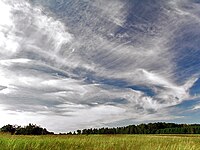
Photo from wikipedia
Abstract. This study presents airborne in-situ and satellite remote sensing climatologies of cirrus clouds and humidity. The climatologies serve as a guide to the properties of cirrus clouds, with the… Click to show full abstract
Abstract. This study presents airborne in-situ and satellite remote sensing climatologies of cirrus clouds and humidity. The climatologies serve as a guide to the properties of cirrus clouds, with the new in-situ data base providing detailed insights into boreal mid-latitudes and the tropics, while the satellite-borne data set offers a global overview. To this end, an extensive, quality checked data archive, the Cirrus Guide II in-situ data base, is created from airborne in-situ measurements during 150 flights in 24 campaigns. The archive contains meteorological parameters, IWC, Nice, Rice, RHice and H2O for each of the flights (IWC: ice water content, Nice: number concentration of ice crystals, Rice: ice crystal mean mass radius, RHice: relative humidity with respect to ice, H2O: water vapor mixing ratio). Depending on the specific parameter, the data base has extended by about a factor of 5–10 compared to the previous studies of Schiller et al. (2008), JGR, and Kramer et al. (2009), ACP. One result of our investigations is, that across all latitudes, the thicker liquid origin cirrus predominate at lower altitudes, while at higher altitudes the thinner in-situ cirrus prevail. Further, exemplary investigations of the radiative characteristics of in-situ and liquid origin cirrus show that the in-situ origin cirrus only slightly warm the atmosphere, while liquid origin cirrus have a strong cooling effect. An important step in completing the Cirrus Guide II is the provision of the global cirrus Nice climatology, derived by means of the retrieval algorithm DARDAR-Nice from ten years of cirrus remote sensing observations from satellite. The in-situ data base has been used to evaluate and adjust the satellite observations. We found that the global median Nice from satellite observations is almost two times higher than the in-situ median and increases slightly with decreasing temperature. Nice medians of the most frequentl occuring cirrus sorted by geographical regions are highest in the tropics, followed by austral/boreal mid-latitudes, Antarctica and the Arctic. Since the satellite climatologies enclose the entire spatial and temporal Nice occurrence, we could deduce that half of the cirrus are located in the lowest, warmest cirrus layer and contain a significant amount of liquid origin cirrus. A specific highlight of the study is the in-situ observations of tropical tropopause layer (TTL) cirrus and humidity in the Asian monsoon anticyclone and the comparison to the surrounding tropics. In the convectively very active Asian monsoon, peak values of Nice and IWC of 30 ppmv and 1000 ppmv are detected around the cold point tropopause (CPT). Above the CPT, ice particles that are convectively injected can locally add a significant amount of water available for exchange with the stratosphere. We found IWCs of up to 8 ppmv in the Asian monsoon in comparison to only 2 ppmv in the surrounding tropics. Also, the highest RHice inside of the clouds as well as in clear sky (120–150 %) are observed around and above the CPT. We attribute this to the high amount of H2O (3–5 ppmv) in comparison to 1.5–3 ppmv in other tropical regions. The supersaturations above the CPT suggest that the water exchange with the stratosphere is 10–20 % higher than expected in regions of weak convective activity and up to about 50 % in the Asian monsoon.
Journal Title: Atmospheric Chemistry and Physics
Year Published: 2020
Link to full text (if available)
Share on Social Media: Sign Up to like & get
recommendations!